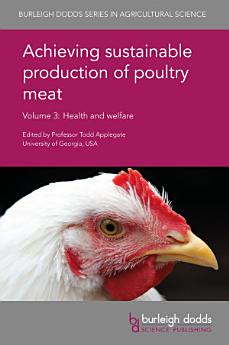Achieving sustainable production of poultry meat Volume 3: Health and welfare
About this ebook
Drawing on an international range of expertise, this book reviews research on poultry health and welfare. Part 1 begins by reviewing the range of diseases and other health issues affecting poultry. It then goes on to discuss ways of preventing and managing disease such as breeding, and means of attenuating the immune system. The second part of the book discusses welfare issues such as management of breeding flocks, housing, transport and humane slaughter techniques.
Achieving sustainable production of poultry meat Volume 3: Health and welfare will be a standard reference for poultry and food scientists in universities, government and other research centres and companies involved in poultry production. It is accompanied by two further volumes which review safety, quality and sustainability as well as poultry breeding and nutrition.
About the author
Dr Todd Applegate is Head of Department and R. Harold and Patsy Harrison Professor of Poultry Science at the University of Georgia, USA. He is a Fellow and former President of the Poultry Science Association (PSA). Amongst other honours, he is a recipient of the PSA’s Evonik Degussa Award for Achievement in Poultry Science. Professor Applegate has edited two previous books for Burleigh Dodds Science Publishing: Achieving sustainable production of poultry meat Volume 2: Breeding and nutrition and Achieving sustainable production of poultry meat Volume 3: Health and welfare, both published in 2017.
Dr Guillermo Tellez Isaias worked at the National Autonomous University of Mexico for 16 years and was previously Head of the Avian Medicine Department at the College of Veterinary Medicine. Currently, Dr Tellez is a Research Professor at the Center of Excellence in Poultry Science, University of Arkansas, USA where his research is focused on the advantages of the poultry gastrointestinal model to evaluate the beneficial effects of functional foods to enhance intestinal health and disease resistance.
Bas Rodenburg studied biology at Wageningen University and graduated in 1998. In 2003, he received his PhD from that same university, focusing his research on feather pecking behaviour in laying hens and how that is related with other behavioural characteristics, such as the ability to cope with fear and stress. After obtaining his PhD, he worked at Livestock Research in Lelystad and at the ILVO in Ghent, Belgium, focusing on research in the area of poultry behaviour and welfare. In 2006, he returned to Wageningen on a personal VENI-grant to investigate the effects of genetic selection and of early-life environment on behaviour of group-housed laying hens. He was recently project leader of a research program aiming to translate scientific knowledge on feather pecking to commercial practice.









